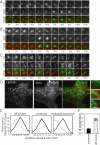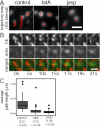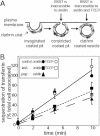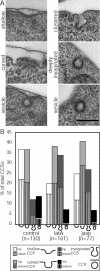A dynamic actin cytoskeleton functions at multiple stages of clathrin-mediated endocytosis
- PMID: 15601897
- PMCID: PMC545926
- DOI: 10.1091/mbc.e04-09-0774
A dynamic actin cytoskeleton functions at multiple stages of clathrin-mediated endocytosis
Abstract
Clathrin-mediated endocytosis in mammalian cells is critical for a variety of cellular processes including nutrient uptake and cell surface receptor down-regulation. Despite the findings that numerous endocytic accessory proteins directly or indirectly regulate actin dynamics and that actin assembly is spatially and temporally coordinated with endocytosis, direct functional evidence for a role of actin during clathrin-coated vesicle formation is lacking. Here, we take parallel biochemical and microscopic approaches to address the contribution of actin polymerization/depolymerization dynamics to clathrin-mediated endocytosis. When measured using live-cell fluorescence microscopy, disruption of the F-actin assembly and disassembly cycle with latrunculin A or jasplakinolide results in near complete cessation of all aspects of clathrin-coated structure (CCS) dynamics. Stage-specific biochemical assays and quantitative fluorescence and electron microscopic analyses establish that F-actin dynamics are required for multiple distinct stages of clathrin-coated vesicle formation, including coated pit formation, constriction, and internalization. In addition, F-actin dynamics are required for observed diverse CCS behaviors, including splitting of CCSs from larger CCSs, merging of CCSs, and lateral mobility on the cell surface. Our results demonstrate a key role for actin during clathrin-mediated endocytosis in mammalian cells.
Figures







Similar articles
-
Structural organization of the actin cytoskeleton at sites of clathrin-mediated endocytosis.Curr Biol. 2011 Jul 26;21(14):1167-75. doi: 10.1016/j.cub.2011.05.048. Epub 2011 Jun 30. Curr Biol. 2011. PMID: 21723126 Free PMC article.
-
Actin dynamics counteract membrane tension during clathrin-mediated endocytosis.Nat Cell Biol. 2011 Aug 14;13(9):1124-31. doi: 10.1038/ncb2307. Nat Cell Biol. 2011. PMID: 21841790 Free PMC article.
-
Coupling between clathrin-coated-pit invagination, cortactin recruitment, and membrane scission observed in live cells.Cell. 2005 May 20;121(4):593-606. doi: 10.1016/j.cell.2005.03.015. Cell. 2005. PMID: 15907472
-
Actin dynamics and endocytosis in yeast and mammals.Curr Opin Biotechnol. 2010 Oct;21(5):604-10. doi: 10.1016/j.copbio.2010.06.006. Epub 2010 Jul 14. Curr Opin Biotechnol. 2010. PMID: 20637595 Free PMC article. Review.
-
Coupling actin dynamics to the endocytic process in Saccharomyces cerevisiae.Protoplasma. 2005 Oct;226(1-2):81-8. doi: 10.1007/s00709-005-0107-5. Epub 2005 Oct 20. Protoplasma. 2005. PMID: 16231104 Review.
Cited by
-
Real-time and label-free monitoring of nanoparticle cellular uptake using capacitance-based assays.Sci Rep. 2016 Sep 19;6:33668. doi: 10.1038/srep33668. Sci Rep. 2016. PMID: 27641838 Free PMC article.
-
A bigger picture: classical cadherins and the dynamic actin cytoskeleton.Nat Rev Mol Cell Biol. 2012 Oct;13(10):673-9. doi: 10.1038/nrm3431. Epub 2012 Aug 30. Nat Rev Mol Cell Biol. 2012. PMID: 22931853 Review.
-
Bending a membrane: how clathrin affects budding.Proc Natl Acad Sci U S A. 2006 Jun 6;103(23):8715-20. doi: 10.1073/pnas.0600312103. Epub 2006 May 30. Proc Natl Acad Sci U S A. 2006. PMID: 16735469 Free PMC article.
-
FM dyes enter via a store-operated calcium channel and modify calcium signaling of cultured astrocytes.Proc Natl Acad Sci U S A. 2009 Dec 22;106(51):21960-5. doi: 10.1073/pnas.0909109106. Epub 2009 Dec 9. Proc Natl Acad Sci U S A. 2009. PMID: 20007370 Free PMC article.
-
Analysis of the AP-2 adaptor complex and cargo during clathrin-mediated endocytosis.Traffic. 2005 Jul;6(7):539-47. doi: 10.1111/j.1600-0854.2005.00280.x. Traffic. 2005. PMID: 15941406 Free PMC article.
References
-
- Ayscough, K. R. (2000). Endocytosis and the development of cell polarity in yeast require a dynamic F-actin cytoskeleton. Curr. Biol. 10, 1587-1590. - PubMed
-
- Axelrod, D. (2001). Total internal reflection fluorescence microscopy in cell biology. Traffic 2, 764-774. - PubMed
-
- Bennett, E. M., Chen, C. Y., Engqvist-Goldstein, A. E., Drubin, D. G., and Brodsky, F. M. (2001). Clathrin hub expression dissociates the actin-binding protein Hip1R from coated pits and disrupts their alignment with the actin cytoskeleton. Traffic 2, 851-858. - PubMed
-
- Bubb, M. R., Senderowicz, A. M., Sausville, E. A., Duncan, K. L., and Korn, E. D. (1994). Jasplakinolide, a cytotoxic natural product, induces actin polymerization and competitively inhibits the binding of phalloidin to F-actin. J. Biol. Chem. 269, 14869-14871. - PubMed
Publication types
MeSH terms
Substances
Grants and funding
LinkOut - more resources
Full Text Sources

